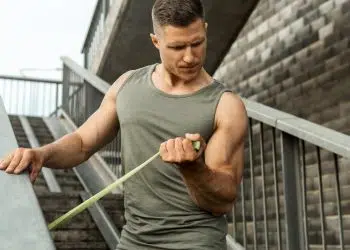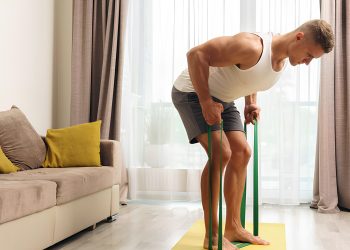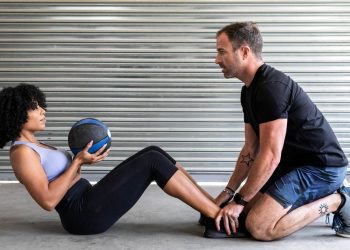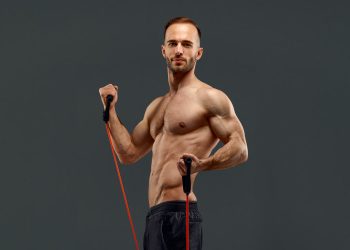With the excessive usage of technology these days, our postures are undoubtedly suffering. As a result, we’re visiting the chiropractor and experiencing back issues like never before. Well, the band pull-apart seeks to counteract this issue by strengthening the back/shoulder muscles associated with a healthy posture.
In an ideal world, we’d make sure we kept our backs straight, shoulders back, and heads up in a perfect line. But that’s not the reality. And if you’re someone who engages in weight training especially, a strong upper posterior (backside of the body) and is really non-negotiable.
You MUST have a strong upper rear to lift heavy weights safely especially during compound exercises (e.g. deadlifts, squats, etc). Not to mention, if you have front-to-back strength imbalances, this technique can fix that too. Although, in a different way than you’d think (stay tuned for details).
Also, you might just have issues with shoulder mobility and therefore, we want you to try this out and tell us if you don’t improve as a result.
Here’s a guide to the band pull-apart and we’ll start off with the muscles that this exercise works…
How To Do The Band Pull-Apart
Here’s a step-by-step on how to execute this exercise. It’s not complex but there are a few key things that you need to be doing to get the best results possible while ensuring your safety. Now, the way that we’re proposing you do this exercise is different than how you’ll usually see it performed.
Level Up Your Fitness: Join our 💪 strong community in Fitness Volt Newsletter. Get daily inspiration, expert-backed workouts, nutrition tips, the latest in strength sports, and the support you need to reach your goals. Subscribe for free!
It’s based on a variation shown by Jeff Cavaliere, M.S.P.T, CSCS (Athlean-X) of which we’ve provided a video of him explaining why this way is better while demonstrating the exercise.
Step 1: Hold the band with an underhand grip a little wider than shoulder-width, keeping your arms straight.
This allows you to maintain the activation of external shoulder rotators that are often underdeveloped, and it’s is also safer on the joints.
Step 2: Slightly protract your shoulders and then raise your arms overhead while creating a little tension in the band.
Step 3: Begin to pull the band apart using your upper back and shoulder muscles, while simultaneously bringing your arms down and back into scapular retraction. Don’t keep your shoulder blades pinched together during the movement. Let them move naturally until the retraction portion of the exercise.
Step 4: Slowly return your arms overhead while still maintaining a little tension in the band, and then repeat.
The reason why we’re starting with the arms overhead and not in front of us is because of the anatomy and function of the muscles being worked here. If you remember from the beginning of the article, we discussed how the role that each muscle plays in specific movements.
The different fibers of the traps allow for different functions that include upward rotation and depression of the scapula and not just retraction of the shoulder blades, which we already do plenty of, with most back and some shoulder exercises.
You can see the exercise at the 4:00 mark if you prefer to skip the explanation.
Target Muscles
The band pull-apart targets a few different muscles located on the rear.
Rotator cuff
The rotator cuff actually consists of four muscles that facilitate arm and shoulder movements. The back rotator cuff muscles include the supraspinatus, infraspinatus, and the teres minor. The front rotator cuff muscle is the subscapularis.
These muscles help secure the top of the upper arm bone (humerus) in the shoulder blade or scapula to function as a ball and socket joint. Although, each has its own function and is attached a little differently to the humerus.
Here’s how each muscle functions…
- Supraspinatus – This muscle is responsible for the abduction of the arms (moves them away from the midline of the body).
- Infraspinatus – This muscle is responsible for lateral rotation of your arm away from the centerline of your body.
- Teres minor – The teres minor is located right below the infraspinatus. It functions to help with lateral (external) rotation of your arm.
- Subscapularis – The subscapularis is the strongest and largest rotator cuff muscle. It’s triangular-shaped and lies deep to the other three muscles. It’s also the most heavily used and is most involved in the rotation of the upper arm toward the center of the body (medial rotation).
Trapezius/traps
The trapezius or traps as we usually refer to this muscle; is trapezoid-shaped and superficially located across the upper back. It extends from where the occipital bone protrudes, down to the thoric vertebrae, and laterally to the spine of the scapula.
The traps are an interesting muscle that consists of three sections of fibers that run in different directions while also facilitating different movements of the scapula.
The upper fibers allow for upward rotation of the scapula, plus extension, rotation, and the tilting of your neck. The middle fibers retract the scapula and the lower fibers function to depress and medially rotate the scapula.
The traps also play a big role in maintaining proper posture by supporting the ideal position of the spine.
But the main thing to understand from the traps anatomy is that these muscles allow for several different functions. Therefore, we have to consider this when determining the best way to perform the band pull-apart.
Deltoids/shoulders
The rear or posterior deltoids make up one of the three heads of the shoulder. It assists the other heads in abducting the arms past 15 degrees along with helping the anterior head to stabilize the arm while the lateral head raises the arm from 15 to 100 degrees. In addition, it helps to stabilize the shoulders in general while providing compensatory forces during the abduction (moving arms away from the midline of the body) of the arms.
The rear deltoids also assist the lats in arm extension during walking.
Rhomboids
The rhomboids are composed of two muscles that help form the shoulder girdle which are the rhomboid major and minor. These muscles lie deep to the trapezius and the major is positioned inferior to the minor.
Level Up Your Fitness: Join our 💪 strong community in Fitness Volt Newsletter. Get daily inspiration, expert-backed workouts, nutrition tips, the latest in strength sports, and the support you need to reach your goals. Subscribe for free!
The rhomboids, through articulation with the trunk, help facilitate movement at the upper posterior in addition to stabilizing the scapula. Its basic functions are retraction, elevation, and rotation of the scapula. In addition, the rhomboids help to maintain the position of the medial border of the scapula to the thoracic wall through protraction.
Benefits of The Band Pull-Apart
Enough good things can’t be said about the benefits of this exercise. Here are several that you should know about if you didn’t before.
Scapular strength and stability
The ability to maintain the scapula in a strong retracted position is an essential component of being able to perform heavy compound exercises safely and effectively.
For example, to perform the deadlift both safely and effectively, it’s very important to be able to pin your shoulders back while keeping them in this position throughout the movement. Otherwise, you’re asking for some serious structural issues somewhere down the line, if not immediately.
Then, if you’re doing the overhead press, you want your scapula to stay pressed up against the back so that you can have proper upward rotation. In addition, you want that stability for the downward movement of the scapula during the eccentric (negative) portion of the overhead press.
Now, what the band pull-apart actually offers is a little different than what you get from doing heavy rows or face pulls. You won’t develop that concentric and eccentric strength to the same extent. But what you are doing is re-educating those rear muscles to function properly through constant repetition while practicing this against enough resistance to train yourself.
Better posture
Good posture comes not only from practicing keeping your shoulders back, back straight, and head up. But the muscles of the upper posterior should have sufficient function and strength to help you consistently maintain this position. When we’re always hunched over with our heads down into our smartphones or laptops, the postural muscles weaken.
As a result, we structurally resemble the Hunchback Of Notre Dame (look him up if you’re unfamiliar). This in combination with ‘forward head posture’ go hand-in-hand and can both thoracic outlet syndrome and decreased respiratory function. Not to mention, it makes you less attractive overall.
Research shows that elastic band exercise is an effective method for improving rounded shoulders and forward head posture. (1)
These types of movements are incredibly beneficial for improving your overall quality of life.
Improved shoulder mobility and stability
Joint mobility often becomes worse as we age. Although a lack of it can cause anyone to have limited movement and range of motion. A lack of mobility in the shoulders can prevent us from being able to raise our arms overhead, extend them behind us, or any other function that the shoulder is capable of.
The band pull-apart takes the shoulders through a larger range of motion beginning from the overhead position and finishing with the arms posteriorly adducted.
Stronger rotator cuffs
You should have a good idea of the function and anatomy of the rotator cuffs as we discussed this at the start of the article. They’re very important muscles and as explained in the video above, using an underhand grip does even more to strengthen them.
Most people don’t do enough work on their rotator cuffs and that’s not a good thing. So, by keeping the shoulders externally rotated throughout the exercise, we’re activating these muscles while doing the band pull-apart. Not to mention, it’s much safer than internally rotating your shoulders which can, and often does, cause shoulder problems down the road.
How Often Can I Do The Band Pull-Apart?
The short answer is that you should be doing it very frequently… like every day. Cavaliere recommends doing just 20-30 reps every day which should take more than 1-2 minutes (everyone has 1-2 minutes to spare every day). But the quality of reps is what matters here most. Therefore, feeling the movement through every part of each rep should be the focus.
How Many Sets/Reps Should I do?
While you can do 20-30 reps for one set every day. You can also increase the resistance and you’ll probably need too once you can do too many reps in a set. If you can do 40-50+ reps, then the benefits start to diminish as there’s no real challenge or sense of needing to work against the resistance.
So, we recommend sometimes doing 10-15 challenging reps but you still need to maintain very good form and control the band during every rep. Because the reps are lower, you can do a few sets at a lower rep range.
Variations of the Band Pull-Apart
While the above variation should be the most basic to get all of the benefits, there are other functional variations if you prefer to include them as well.
Tall-kneeling band pull-apart
The tall-kneeling variation removes the lower-body, therefore, forcing you to focus more on the pull-apart of which some people will find useful. Although, it’s not necessarily better than the standing variation. But some people seem to involve too much lower-body or even lower back, which reduces the overall effectiveness of the exercise.
So for this variation, you’re basically sitting on the floor with your knees and toes supporting your body weight while your entire torso is extended. Everything else remains the same.
Diagonal band pull-apart
The diagonal band pull-apart is a great variation that involves pulling the band apart in a diagonal direction. We recommend using an underhand or neutral grip (lace band between your fingers) for this one to still take advantage of the benefits of keeping your shoulders externally rotated.
- Pull the band diagonally across your body so that one arm is pulling down and the upper is pulling up. Make sure to repeat in the opposite direction as well.
Bent-over band pull-apart
So this variation allows you to mimic the body position used during the deadlift or bent-over row. This carries over into the actual exercises and as a result, you’ll be better because of it.
- Bend at the knees and hinge forward at the hips while keeping your back straight. Then, perform the pull-apart as explained in the instructions, still using an underhand grip.
Wrapping Up
The band pull-apart should be a regular in your daily fitness regime. And even if you’re not into fitness (that’s OK too) and want to improve your posture and shoulder mobility, you can (and should) take advantage of the benefits.
Hopefully, you learned a little more than you what you expected regarding the anatomy and functions of the muscles involved. It’s a must-have especially if you’re used to having bad posture and even if you want to prevent certain issues from occurring.












